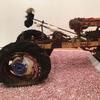'Dreams in Dust: The Pastels of Lucas Samaras' Exhibition Opens at the Morgan in May
- NEW YORK, New York
- /
- April 04, 2016

During the first three decades of his long career, American artist Lucas Samaras (b. 1936 in Greece) turned to pastel to produce small, intimate works that explored themes present in his better-known paintings, sculptures, and installations. He was attracted to pastel’s bright colors and shimmering surface, and also to the fact that it was an unfashionable medium in postwar American art. Dreams in Dust: The Pastels of Lucas Samaras, on view beginning May 6, celebrates the gift of fortyeight works to the Morgan from the artist and his dealer Arne Glimcher. Dating to the years 1958-1983, they range in subject matter from dreamlike seascapes and interiors to self-portraits, nudes, and still life. The installation of the exhibition was conceived in collaboration with the artist, who designed a wallpaper for it. The works will be presented in chronological order highlighting four successive phases of production. Dreams in Dust will remain on view at the Morgan through August 21.
“The Morgan is delighted to present this exhibition of Lucas Samaras’s work in a medium noted for its vibrancy,” said Colin B. Bailey, director of the museum. “His pastels are extraordinarily diverse in subject and composition, and offer a highly personal look at the artist early in his career. We are deeply grateful to Lucas and to Arne Glimcher for their gift to the Morgan and for their involvement in this important exhibition.”
1958–62: Early Pastels Samaras’s earliest pastels, made on cheap, colored construction paper, reflect his love of patterns and rich color contrasts—especially deep blue and red. Their inspiration ranges from modern masters—notably colorists such as Henri Matisse and Hans Hofmann—to pornographic magazines. They also reflect Samaras’s interest in theater with their imaginary scenes and stagelike compositions.
For Samaras, the shimmering effect of pastel—owing to the way the powdery substance catches the light from many directions—was as important as the vividness of its color. He recalled how during his childhood relatives who were in the fur business would bring back shiny fabrics from their travels. To recapture this fairy-tale atmosphere, the artist enhanced the jewel-like aspect of some of his early pastels with the addition of gold and silver metallic paint, which is apparent in his 1958 still life.
During this period Samaras was also taking classes at Stella Adler’s acting studio, and became involved in loosely structured theatrical performances known as “Happenings” in lofts and galleries. He also wrote plotless and irrational narratives though he never physically enacted them. He did, however, give visual form to some of these in his pastels—employing imagery associated with private fantasies, eroticism, and violence.
1965: Geometric Abstraction In the 1960s Samaras’s pastel work demonstrates engagement with the Pop Art and Minimalism movements through his use of close-up and geometric abstraction, though the small size of his compositions and the softness of the powdery pastel medium contrasts starkly with the large-scale, hard-edge aesthetic predominant at the time. Instead of a torchon, or stump, the traditional implement used for blending pastels, Samaras used his finger to achieve smooth color gradations. He considers this an advantage. “ ... I didn’t have to use a brush. I was using a finger. So there was a subtlety to the changes, there was a—it was almost a fog or something that emerged . . . there’s a word for—the Italians use it: sfumato.” A 1965 self-portrait of sorts depicts his own finger as a drawing implement.
1974: Vibrant Creativity After a lapse of nine years, Samaras took up pastel again, creating one hundred works during the summer and early fall of 1974. Many include heavily patterned compositions combining interiors, flowers, and seascapes.
In the artist’s seascapes dissolving figures eerily turn into hallucinations. In the left section of Untitled, August 14, 1974, two blue eyes peer at the viewer from the surface of the water.
1981–83: Psychological Intensity Samaras’s last phase of pastel production to date is dominated by self-portraits—of which he made approximately two hundred. The broader palette and high-keyed colors applied in multiple layers create a rich texture while the expressionist handling—reminiscent of Van Gogh—heightens the psychological intensity of the images. In some of them a single eye in the center of the sheet stares at the viewer, epitomizing the hypnotic character of Samaras’s imagery.
Born in Kastoria, Greece, in 1936, Lucas Samaras immigrated to the U.S. in 1948, during the Greek Civil War. In the mid-1950s he enrolled at Rutgers University, then a hotbed of avantgarde experimentation, where he studied with Allan Kaprow.
In the 1960s, Samaras became known for his sculptures in which he transformed familiar objects, such as chairs and boxes, into artworks at once seductive and threatening with their combination of vivid colors, mirrors, pins, and knives. In 1966 he created one of the first immersive installations, a mirrored room that viewers could enter.
With the Auto-Polaroid and Photo-Transformation series of 1969 to 1976, photography became a central medium for Samaras, who produced dizzying images—typically featuring himself as a subject—by manipulating the surface of the film during development. Since 2001, he has continued his photographic experiments using digital technology to create haunting portraits.
Disguise, distortion, and transformation have remained at the core of his widely varied production, which, in addition to photography, encompasses painting, drawing, sculpture, films, videos, assemblages, and installations.









![Peter Paul Rubens (Flemish, 1577–1640), After Titian (Tiziano Vecelli) (Italian [Venetian], c. 1488–1576), Rape of Europa, 1628–29. Oil on canvas, 71 7/8 x 79 3/8 in. Peter Paul Rubens (Flemish, 1577–1640), After Titian (Tiziano Vecelli) (Italian [Venetian], c. 1488–1576), Rape of Europa, 1628–29. Oil on canvas, 71 7/8 x 79 3/8 in.](/images/c/e2/2e/Jan20_Rape_of_Europa100x100_c.jpg)






